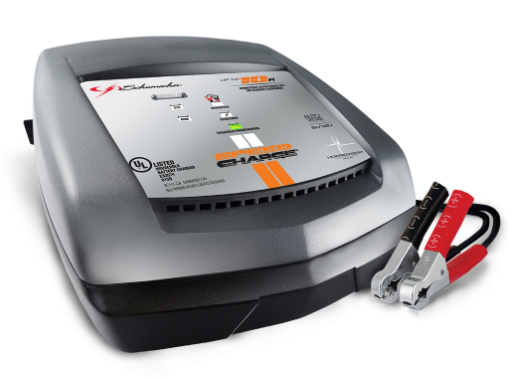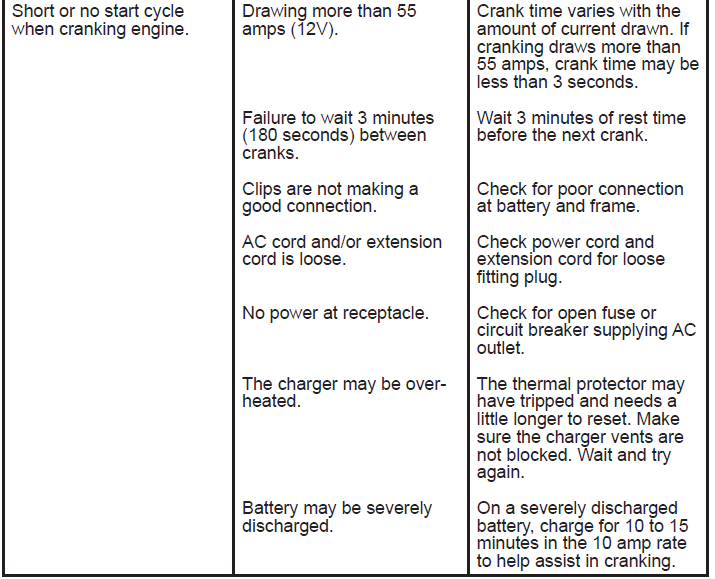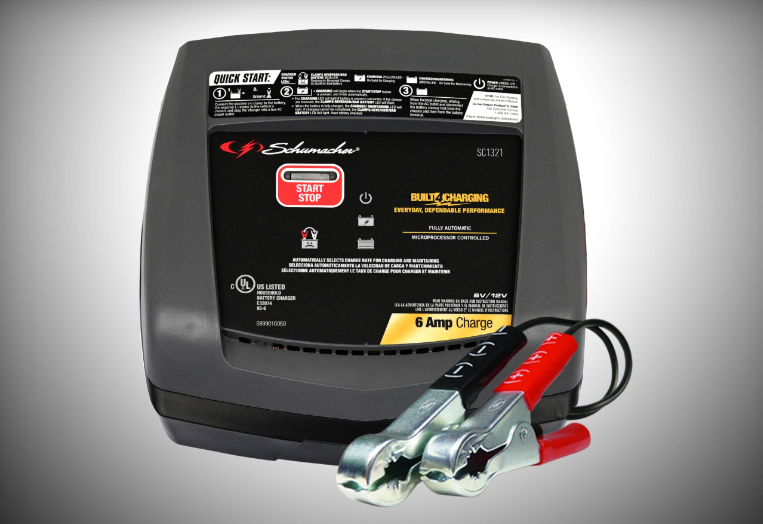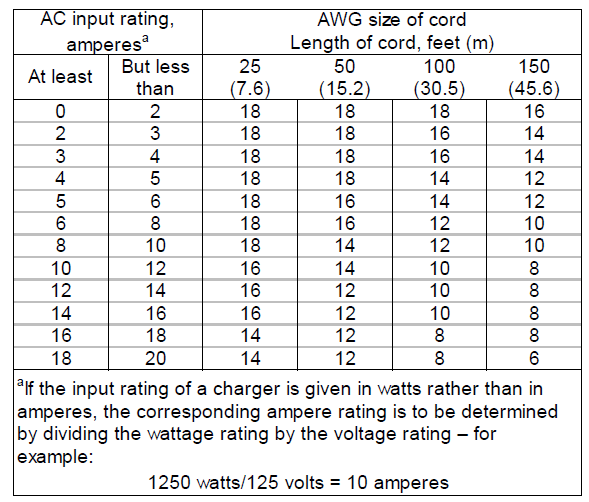
Schumacher Electric XC10 Automatic Battery Charger

IMPORTANT SAFETY INSTRUCTIONS
- SAVE THESE INSTRUCTIONS – The NAPA 85-435 offers a wide range of features to accommodate your needs. This manual will show you how to use your charger safely and effectively. Please read, understand and follow these instructions and precautions carefully, as this manual contains important safety and operating instructions.
- WARNING: Pursuant to California Proposition 65, this product contains chemicals known to the State of California to cause cancer and birth defects or other reproductive harm.
- Do not expose the charger to rain or snow.
- Use only recommended attachments. Use of an attachment not recommended or sold by the battery charger manufacturer may result in a risk of fire, electric shock or injury to persons or property damage.
- To reduce the risk of damage to the electric plug or cord, pull by the plug rather than the cord when disconnecting the charger.
- An extension cord should not be used unless necessary. Use of an improper extension cord could result in a risk of fire and electric shock. If an extension cord must be used, make sure:
- That the pins on the plug of the extension cord are the same number, size and shape as those of the plug on the charger.
- The extension cord is properly wired and in good electrical condition.
- The wire size is large enough for the AC ampere rating of the charger as specified in the table in Section 8.2.
- Do not operate the charger with a damaged cord or plug; take it to a qualified service person. (Call customer service at: 1-800-621-5485.)
- Do not operate the charger if it has received a sharp blow, been dropped or otherwise damaged in any way; take it to a qualified service person. (Call customer service at: 1-800-621-5485.)
- Do not disassemble the charger; take it to a qualified service person when service or repair is required. Incorrect reassembly may result in a risk of fire or electric shock. (Call customer service at: 1-800-621-5485.)
- To reduce the risk of electric shock, unplug the charger from the outlet before attempting any maintenance or cleaning. Simply turning off the controls will not reduce this risk.
WARNING – RISK OF EXPLOSIVE GASES. WORKING IN THE VICINITY OF A LEAD-ACID BATTERY IS DANGEROUS. BATTERIES GENERATE EXPLOSIVE GASES DURING NORMAL BATTERY OPERATION. FOR THIS REASON, IT IS OF UTMOST IMPORTANCE THAT YOU FOLLOW THE INSTRUCTIONS EACH TIME YOU USE THE CHARGER. TO REDUCE THE RISK OF A BATTERY EXPLOSION, FOLLOW THESE INSTRUCTIONS AND THOSE PUBLISHED BY THE BATTERY MANUFACTURER AND THE MANUFACTURER OF ANY EQUIPMENT YOU INTEND TO USE IN THE VICINITY OF THE BATTERY. REVIEW THE CAUTIONARY MARKINGS ON THESE PRODUCTS AND ON THE ENGINE.
PERSONAL PRECAUTIONS
- Consider having someone close enough by to come to your aid when you work near a lead-acid battery.
- Have plenty of fresh water and soap nearby in case battery acid contacts your skin, clothing or eyes.
- Wear complete eye and body protection, including safety goggles and protective clothing. Avoid touching your eyes while working near the battery.
- If battery acid contacts your skin or clothing, immediately wash the area with soap and water. If acid enters your eye, immediately flood the eye with cold running water for at least 10 minutes and get medical attention right away.
- NEVER smoke or allow a spark or flame in the vicinity of a battery or engine.
- Be extra cautious to reduce the risk of dropping a metal tool onto the battery. It might spark or short-circuit the battery or other electrical parts which may cause an explosion.
- Remove personal metal items such as rings, bracelets, necklaces, and watches when working with a lead-acid battery. A lead-acid battery can produce a short-circuit current high enough to weld a ring or the like to metal, causing a severe burn.
- Use this charger for charging LEAD-ACID batteries only. It is not intended to supply power to a low-voltage electrical system other than in a starter motor application. Do not use this battery charger for charging dry-cell batteries that are commonly used with home appliances. These batteries may burst and cause injury to persons and property damage.
- NEVER charge a frozen battery.
- NEVER overcharge a battery.
PREPARING TO CHARGE
- If it is necessary to remove the battery from the vehicle to charge it, always remove the grounded terminal first. Make sure all of the accessories in the vehicle are off to prevent arcing.
- Be sure the area around the battery is well ventilated while the battery is being charged.
- Clean the battery terminals before charging the battery. During cleaning, keep airborne corrosion from coming into contact with your eyes, nose, and mouth. Use baking soda and water to neutralize the battery acid and help eliminate airborne corrosion. Do not touch your eyes, nose, or mouth.
- Add distilled water to each cell until the battery acid reaches the level specified by the battery manufacturer. Do not overfill. For a battery without removable cell caps, such as valve-regulated lead-acid batteries (VRLA), carefully follow the manufacturer’s recharging instructions.
- Read, understand, and follow all instructions for the charger, battery, vehicle and any equipment used near the battery and charger. Study all of the battery manufacturer’s specific precautions while charging and recommended rates of charge.
- Determine the voltage of the battery by referring to the vehicle owner’s manual and make sure that the output voltage selector switch is set to the correct voltage. If the charger has an adjustable charge rate, charge the battery at the lowest rate first.
- Make sure that the charger cable clips make tight connections.
CHARGER LOCATION
- Locate the charger as far away from the battery as the DC cables permit.
- Never place the charger directly above the battery being charged; gases from the battery will corrode and damage the charger.
- Do not set the battery on top of the charger.
- Never allow battery acid to drip onto the charger when reading the electrolyte specific gravity or filling the battery.
- Do not operate the charger in a closed-in area or restrict the ventilation in any way.
DC CONNECTION PRECAUTIONS
- Connect and disconnect the DC output clips only after setting all of the charger switches to the “off” position and removing the AC plug from the electrical outlet. Never allow the clips to touch each other.
- Attach the clips to the battery and chassis, as indicated in steps 6.5, 6.6, and 7.2 through 7.4.
FOLLOW THESE STEPS WHEN THE BATTERY IS INSTALLED IN THE VEHICLE.
A SPARK NEAR THE BATTERY MAY CAUSE A BATTERY EXPLOSION. TO REDUCE THE RISK OF A SPARK NEAR THE BATTERY:
- Position the AC and DC cables to reduce the risk of damage from the hood, door, and moving or hot engine parts.
- Stay clear of fan blades, belts, pulleys, and other parts that can cause injury.
- Check the polarity of the battery posts. The POSITIVE (POS, P, +) battery post usually has a larger diameter then the NEGATIVE (NEG, N, -) post.
- Determine which post of the battery is grounded (connected) to the chassis. If the negative post is grounded to the chassis (as in most vehicles), see step 6.5. If the positive post is grounded to the chassis, see step 6.6.
- For a negative-grounded vehicle, connect the POSITIVE (RED) clip from the battery charger to the POSITIVE (POS, P, +) ungrounded post of the battery. Connect the NEGATIVE (BLACK) clip to the vehicle chassis or engine block away from the battery. Do not connect the clip to the carburetor, fuel lines, or sheet-metal body parts. Connect to a heavy-gauge metal part of the frame or engine block.
- For a positive-grounded vehicle, connect the NEGATIVE (BLACK) clip from the battery charger to the NEGATIVE (NEG, N, -) ungrounded post of the battery. Connect the POSITIVE (RED) clip to the vehicle chassis or engine block away from the battery. Do not connect the clip to the carburetor, fuel lines, or sheet-metal body parts. Connect to a heavy-gauge metal part of the frame or engine block.
- When disconnecting the charger, turn all switches off, disconnect the AC cord, remove the clip from the vehicle chassis, and then remove the clip from the battery terminal.
- See CALCULATING CHARGE TIME for length of charge information.
FOLLOW THESE STEPS WHEN THE BATTERY IS OUTSIDE THE VEHICLE.
A SPARK NEAR THE BATTERY MAY CAUSE A BATTERY EXPLOSION. TO REDUCE THE RISK OF A SPARK NEAR THE BATTERY:
- Check the polarity of the battery posts. The POSITIVE (POS, P, +) battery post usually has a larger diameter than the NEGATIVE (NEG, N, -) post.
- Attach at least a 24-inch (61 cm) long 6-gauge (AWG) insulated battery cable to the NEGATIVE (NEG, N, -) battery post.
- Connect the POSITIVE (RED) charger clip to the POSITIVE (POS, P, +) post of the battery.
- Position yourself and the free end of the cable you previously attached to the NEGATIVE (NEG, N, -) battery post as far away from the battery as possible, then connect the NEGATIVE (BLACK) charger clip to the free end of the cable.
- Do not face the battery when making the final connection.
- When disconnecting the charger, always do so in the reverse order of the connecting procedure and break the first connection as far away from the battery as practically.
- A marine (boat) battery must be removed and charged on shore. To charge it onboard requires equipment specially designed for marine use.
BATTERY C 8. HARGING – AC CONNECTIONS
- This battery charger is for use on a nominal 120-volt circuit.
DANGER – Never alter the AC cord or plug provided – if it does not fit the outlet, have a proper grounded outlet installed by a qualified electrician. Improper connection can result in a risk of an electric shock or electrocution.
NOTE: The use of an adapter plug is not recommended. - Recommended minimum AWG size for extension cords for battery chargers:

FEATURES

- Charge Rate Selector Switch
- Charging/Engine Cranking Selector Switch
- Battery Type Switch
- Full Charge LED
- AC Power LED
ASSEMBLY INSTRUCTIONS
- This charger comes equipped with cable holders. Insert these into any of the six holes found on the back of the charger. Wrap the cables around these holders for convenient storage.
CONTROL PANEL

Battery Type Switch
Use this button to set the type of battery to be charged.
- Regular – Set the button to STARTING BATTERY. This battery type is usually used in cars, trucks, and motorcycles. These batteries have vent caps and are often marked “Low Maintenance” or “Maintenance-free”. This type of battery is designed to deliver quick bursts of energy (such as starting engines) and have a greater plate count. The plates will also
be thinner and have somewhat different material composition. Regular batteries should not be used for deep-cycle applications. - Deep-Cycle – Set the button to DEEP CYCLE/GEL BATTERY. Deep-cycle batteries are usually marked as “Deep-Cycle” or “Marine”. Deep-cycle batteries are usually larger than the other types. This type of battery has less instant energy but somewhat greater long-term energy delivery than regular batteries. Deep cycle batteries have thicker plates and can survive a number of discharge cycles.
- AGM – Set the button to DEEP CYCLE/GEL BATTERY. The Absorbed Glass Matt construction allows the electrolyte to be suspended in close proximity to the plate’s active material. In theory, this enhances both the discharge and recharge efficiency. Actually, the AGM batteries are a variant of Sealed VRLA (valve-regulated lead-acid) batteries. Popular uses include high-performance engine starting, power sports, deep cycle, solar and storage batteries. AGM batteries are typically good deep cycle batteries, and they deliver best life performance if recharged before the battery drops below a 50 percent charge. If these AGM batteries are completely discharged, the cycle life will be around 300 cycles. This is true of most AGM batteries rated as deep-cycle batteries.
- GEL – Set the button to DEEP CYCLE/GEL BATTERY. The Gel Cell is similar to the AGM style because the electrolyte is suspended, but different because, technically, the AGM battery is still considered to be a wet cell. The electrolyte in a GEL cell has a silica additive that causes it to set up or stiffen. The recharge voltages on this type of cell are lower than the other styles of lead-acid battery. This is probably the most sensitive cell in terms of adverse reactions to over-voltage charging. Gel Batteries are best used in VERY DEEP cycle applications and may last a bit longer in hot weather applications. If the incorrect battery charger is used on a Gel Cell battery, poor performance and premature failure
is certain.
Charge Rate Selector Switch Use the Charge Rate selector switch to select the charge rate or engine starting setting you require.
- 2A Slow Charge Rate – Intended for charging small batteries such as those commonly used in garden tractors, snow mobiles and motorcycles.
NOTE: The 2A rate is not to be used as a trickle charger for larger batteries. - 10A Fast Charge Rate – Use for charging automotive, marine and deep-cycle batteries. Not intended for industrial applications.
- 55A Engine Start – Provides 55 amps for cranking an engine with a weak or run-down battery. Always use in combination with a battery.
OPERATING INSTRUCTIONS
Charging
- Connect the battery following the precautions listed in Sections 6 and 7.
- Select the appropriate settings for your battery.
- Connect the AC power following the precautions listed in Section 8.
Automatic Charging Mode
When an Automatic Charge is performed, the charger switches to the Maintain Mode (see below) automatically after the battery is charged.
Completion of Charge
Charge completion is indicated by the FULL CHARGE (green) LED. When lit, the charger has stopped charging and switched to the Maintain Mode of operation. If the 12V DEEP CYCLE battery type was selected, the FULL CHARGE (green) LED comes on when the battery is charged enough for normal use.
Maintain Mode
When the FULL CHARGE (green) LED is flashing, the charger has started Maintain Mode. In this mode, the charger keeps the battery fully charged by delivering a small current when necessary. If the battery voltage drops below a preset level, the charger will go back into Charge Mode until the battery voltage returns to the full charge level, at which point the charger will return to Maintain Mode. The voltage is maintained at a level determined by the BATTERY TYPE selected.
NOTE: The charger automatically switches between Charge Mode and Maintain Mode as necessary. The FULL CHARGE (green) LED will cycle on when the battery is at full charge and off when the voltage drops below a preset level and the charger goes into Charge Mode. This cycle will continue, and the FULL CHARGE (green) LED will flash for longer periods as the battery becomes more fully charged.
Using the Engine Start feature
Your battery charger can be used to jumpstart your car if the battery is low. Follow these instructions on how to use the ENGINE START feature.
IMPORTANT: Follow all safety instructions and precautions for charging your battery. Wear complete eye and clothing protection. Charge your battery in a well-ventilated area.
IMPORTANT: Using the ENGINE START feature WITHOUT a battery installed in the vehicle could cause damage to the vehicle’s electrical system.
- With the charger unplugged from the AC outlet, connect the charger to the battery following the instructions given in Section 6 (FOLLOW THESE STEPS WHEN THE BATTERY IS INSTALLED IN A VEHICLE).
- Plug the charger’s AC power cord into the AC outlet.
- With the charger plugged in and connected to the battery of the vehicle, set the charging/engine cranking selector switch to the engine start position.
- Crank the engine until it starts or 5 seconds pass. If the engine does not start, wait 3 minutes before cranking again.
NOTE: During extremely cold weather, or if the battery is under 2 volts, charge the battery for 5 minutes before cranking the engine. - If the engine fails to start, charge the battery for 5 more minutes before attempting to crank the engine again.
- After the engine starts, unplug the AC power cord before disconnecting the battery clips from the vehicle.
- Clean and store the charger in a dry location.
NOTE: If the engine does turn over, but never starts, there is no problem with the starting system; there is a problem somewhere else with the vehicle. STOP cranking the engine until the other problem has been diagnosed and corrected.
Charging Tips
Read this entire manual before using your battery charger. The following tips serve only as a guide for specific situations.
- If your vehicle won’t start, It is not necessary to fully charge your battery to start a vehicle. When the battery’s charge is 77% or more, the battery has usually been charged enough for the vehicle to start and operate normally. If operating the vehicle continuously for an extended period (such as a long drive), the vehicle’s charging system should charge the battery back to normal during that period. If the vehicle will only be operated for a short period (short drive), the battery might need to be charged again before it can start the vehicle again.
- Completing an interrupted charge – Once the battery has reached 85% charge, if the charging process is interrupted and restarted, the charger could go straight into Maintain Mode. However, if the original charge was started using the 10A rate, the charge can often be completed using the 2A rate.
MAINTENANCE INSTRUCTIONS
- Before performing maintenance, unplug and disconnect the battery charger (see Sections 6, 7 and 8).
- After use, unplug the charger and use a dry cloth to wipe all battery corrosion and other dirt or oil from the terminals, cords, and the charger case.
- Servicing does not require opening the unit, as there are no user-serviceable parts.
STORAGE INSTRUCTIONS
- Store the charger unplugged, in an upright position. The cord will still conduct electricity until it is unplugged from the outlet.
- Store inside, in a cool, dry place (unless you’re using an on-board Marine Charger).
- Do not store the clips on the handle, clipped together, on or around metal, or clipped to cables.
TROUBLESHOOTING



LIMITED WARRANTY
SCHUMACHER ELECTRIC CORPORATION, 801 BUSINESS CENTER DRIVE, MOUNT PROSPECT, IL 60056-2179, MAKES THIS LIMITED WARRANTY TO THE ORIGINAL RETAIL PURCHASER OF THIS PRODUCT. THIS LIMITED WARRANTY IS NOT TRANSFERABLE OR ASSIGNABLE.
Schumacher Electric Corporation (the “Manufacturer”) warrants this battery charger for 2 years from the date of purchase at retail against defective material or workmanship that may occur under normal use and care. If your unit is not free from defective material or workmanship, the Manufacturer’s obligation under this warranty is solely to repair or replace your product with a new or reconditioned unit at the option of the Manufacturer. It is the obligation of the purchaser to forward the unit, along with mailing charges prepaid to the Manufacturer or its authorized representatives for repair or replacement to occur. The manufacturer does not provide any warranty for any accessories used with this product that are not manufactured by Schumacher Electric Corporation and approved for use with this product. This Limited Warranty is void if the product is misused, subjected to careless handling, repaired or modified by anyone other than the Manufacturer, or if this unit is resold through an unauthorized retailer. The manufacturer makes no other warranties, including, but not limited to, express, implie,d or statutory warranties, including without limitation, any implied warranty of merchantability or implied warranty of fitness for a particular purpose. Further, the Manufacturer shall not be liable for any incidental, special or consequential damage claims incurred by purchasers, users, or others associated with this product, including, but not limited to, lost profits, revenues, anticipated sales, business opportunities, goodwill, business interruption, and any other injury or damage. Any such warranties, other than the limited warranty included herein, are hereby expressly disclaimed and excluded. Some states do not allow the exclusion or limitation of incidental or consequential damages or the length of implied warranty, so the above limitations or exclusions may not apply to you. This warranty gives you specific legal rights, and you may have other rights that vary from this warranty.
THIS LIMITED WARRANTY IS THE ONLY EXPRESS LIMITED WARRANTY AND THE MANUFACTURER NEITHER ASSUMES NOR AUTHORIZES ANYONE TO ASSUME OR MAKE ANY OTHER OBLIGATION TOWARDS THE PRODUCT OTHER THAN THIS WARRANTY.
For more manuals by Schumacher, visit ManualsLibraryy
Schumacher Electric XC10 Automatic Battery Charger-FAQs
Can the Rival Crock-Pot insert go in the oven?
Yes, the removable stoneware insert can be used in the oven up to 400°F. Always remove the lid before placing it in the oven.
Is the Crock-Pot insert microwave-safe?
Yes, the stoneware insert (without lid) is safe for use in the microwave.
Can the glass lid go in the oven or microwave?
No, the lid is not safe for use in either the oven or microwave. Only the stoneware insert is heat-resistant for those uses.
Is the Crock-Pot dishwasher-safe?
Yes, both the removable insert and lid are dishwasher-safe for easy cleanup.
Can I use the Crock-Pot on a stovetop?
No, never place the stoneware insert on a stove burner. It may crack due to direct heat.
What are the standard heat settings?
Most Rival models offer Low, High, and Warm settings to accommodate different cooking needs.
Can I leave the Crock-Pot on while I’m away?
Yes, slow cookers are designed to operate safely for extended periods. Just ensure it’s on a flat surface and away from flammable items.
How long can food stay on the “Warm” setting?
Food can typically be kept warm for up to 4 hours. After that, it may begin to dry out or lose quality.
Can I cook frozen meat or ingredients directly in it?
It’s recommended to thaw food first to ensure even cooking and food safety.
Does the Rival Crock-Pot come in different sizes?
Yes, Rival offers various sizes ranging from small (2–3 quarts) to large (6–7 quarts), depending on your cooking needs.


